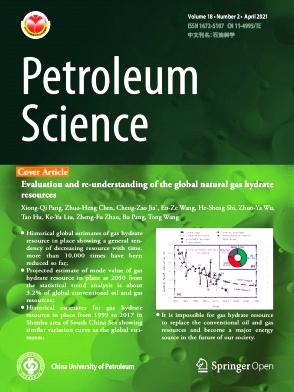利用随钻x射线测井(LWD)密度成像工具进行薄层识别
IF 6.1
1区 工程技术
Q2 ENERGY & FUELS
引用次数: 0
摘要
随着石油勘探和地下资源开发需求的增加,密度成像在薄层识别中发挥着越来越重要的作用。然而,传统的密度成像工具受到垂直分辨率差的限制,因此在准确估计薄层厚度和相对倾角时存在误差。这影响了薄层油气储量的准确评价。为了解决这一问题,本研究评估了采用基于先进工具设计的新方法的可行性。首先,选择一种电子可控x射线源来取代传统的Cs-137源,旨在提高工具的垂直分辨率,同时降低通常与化学源相关的放射性风险。仿真结果表明,x射线工具在保持相同测量灵敏度的同时,提供了足够的探测深度和更好的垂直分辨率。在工具设计确定后,改进Fisher最优分割方法,增强对薄层厚度和相对倾角的估计。这是通过将识别薄层接口转化为数学聚类问题来完成的。采用非线性最小二乘法对薄层界面进行拟合,实现了薄层界面参数的计算。结果表明,薄层厚度的RMSE(均方根误差)降低了38.5%,相对倾角的RMSE降低了33.7%,证明了增强x射线工具在薄层识别方面的优越性能。该研究为薄层油气密度成像工具的设计和评价提供了新的思路,为薄层油气储量评价和开发决策提供了依据。本文章由计算机程序翻译,如有差异,请以英文原文为准。
Thin layer identification using a theoretical X-ray logging while drilling (LWD) density imaging tool
With the increasing demand for oil exploration and subsurface resource development, density imaging plays an increasingly important role in identifying thin layers. However, conventional density imaging tools are limited by poor vertical resolution and therefore suffer from errors in accurately estimating the thickness and relative dip angle of thin layers. This affects the accurate evaluation of thin layer oil and gas reserves. To address this issue, this study evaluates the feasibility of employing novel methods based on advanced tool design. First, an electronically controllable X-ray source is selected to replace the traditional Cs-137 source, aiming to improve the tool's vertical resolution while reducing the radioactive risks commonly associated with chemical sources. Simulation results show that the X-ray tool provides sufficient depth of investigation with better vertical resolution while maintaining the same level of measurement sensitivity. Once the tool design is established, Fisher's optimal segmentation method is improved to enhance the estimation of thin layer thickness and relative dip angle. This is completed by transforming identifying thin layer interface into a mathematical clustering problem. The thin layer interface is fitted using the nonlinear least squares method, which enables the calculation of its parameters. The results demonstrate a 38.5% reduction in RMSE (root mean square error) for thin layer thickness and a 33.7% reduction in RMSE for relative dip angle, demonstrating the superior performance of enhanced X-ray tool in thin layer identification. This study provides a new perspective on the design of density imaging tools and assessment of thin layer, which can help in future thin layer hydrocarbon reserves evaluation and development decisions.
求助全文
通过发布文献求助,成功后即可免费获取论文全文。
去求助
来源期刊

Petroleum Science
地学-地球化学与地球物理
CiteScore
7.70
自引率
16.10%
发文量
311
审稿时长
63 days
期刊介绍:
Petroleum Science is the only English journal in China on petroleum science and technology that is intended for professionals engaged in petroleum science research and technical applications all over the world, as well as the managerial personnel of oil companies. It covers petroleum geology, petroleum geophysics, petroleum engineering, petrochemistry & chemical engineering, petroleum mechanics, and economic management. It aims to introduce the latest results in oil industry research in China, promote cooperation in petroleum science research between China and the rest of the world, and build a bridge for scientific communication between China and the world.
 求助内容:
求助内容: 应助结果提醒方式:
应助结果提醒方式:


